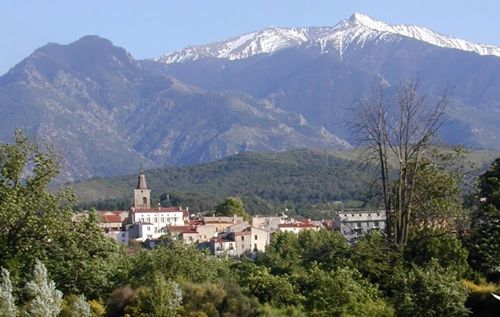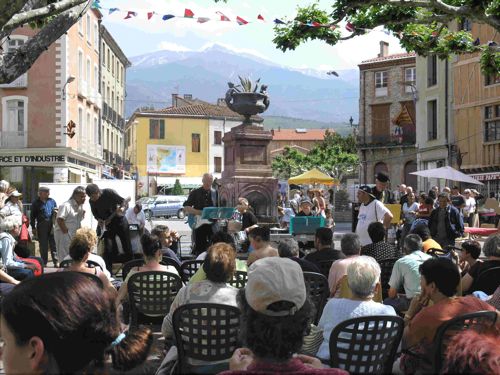Prades
with Norman Longworth
(Taken from the one-day-to-be-published ‘Conflent Tales’)

My town of Prades is the regional capital of the Conflent. It finds itself plumb in the centre of the Conflent just where the valley of the Tet begins its climb into the high Pyrennees.
It’s a pretty town, though Mr Michelin did not see fit to give it even one star in his celebrated green guides. Maybe it’s because it has the feeling and smell of a busy working community and he got a bit sniffy about that. But the views from the town centre are real enough. In the snow-filled winter, the Canigou seems to rise abruptly out of the Southern outskirts of the town like a majestic 9000 foot high cream-cake. And on its Western and Northern sides the peaks of the Lower Pyrennees and the Fenouilledes answer defiantly back.
For a town so squeezed in a magnificent monster mountain garlic crusher, Prades could not be more serene. It’s so laid back that people walking the streets after 8 pm are considered to be peculiar, mad or up to no good. Just joking of course, but sometimes even I often wonder if the place has become a ghost town.

Part of the Plane-tree covered Prades market
But this is usually during the winter somnolence. After that’s over, the town springs and summers into life as if to make up for all that inactivity. It bubbles like a discontented geyser. To feel the sheer frenetic ambience of the place, you should visit on a Tuesday morning, when the two squares and the surrounding streets dance and resonate to the frantic bustle and chatter of the weekly market. Here you will be able to sample, there and then, the culinary delights that set the stomach in motion and the appetite into freefall – chorizos from South America, subtle delicacies from the South Seas, boles de Picolat, spicy meat balls in a tangy sauce, and, this being Catalonia, a truly giant paella from which gourmands like you can savour a pan-lid full of crustaces, chicken and saffron rice.
Should you wish to delay these pleasures of the table, there are the joys of the palate to be transported home – cheeses of every variety including the delicious Pyrennean Manchego and Etorki, cheeses from cow, sheep and goat, cheeses hard as iron, cheeses soft as fleece and cheeses in colours and states of a viscosity unseen in British markets.

In the summer, it’s one of my weekly diversions to watch bemused Brits circulate the stands with perplexed expressions, as if suffering from shell-shock. Their olfactory senses are being invaded by odours they have rarely experienced, and their brains are overwhelmed by the diversity. The full array of stalls is bewildering for the unsuspecting grockel.
One of them appeals solely to the connoisseur of prunes and displays several varieties of this very useful working fruit. Many customers for this product tend to be well advanced in years. Another stand will pander to the olive fanatic, tens of different olives in tens of different dressings, bland and piquant, black and green, large and tiny, laurel and hardy; yet another will concentrate on mushrooms, cepes, girolles, the delicious chanterelles and the sinister sounding trompettes de la mort, each separate variety destined for a different dish. My Catalan friends and neighbours know their cuisine.
And of course there are the products of the region, fruits of every kind, vegetables of every persuasion, wines of every strength and sausages of every content. The Prades market is a truly happy and animated affair – musicians abound, accordionists, violinists, trumpeters, guitarists, saxophonists and more. One of them even plays the triangle. Together it is a symphony of sound – and a magnet for people from all the villages of the Conflent and beyond. In summer the whole scene resembles one of USAP’s more violent rugby scrums – pushing, pulling, scratching, fighting and the odd touch of eye-gouging when the referee isn’t looking.

After the market it is chattering time. The étrangers gather in the Café de France to exchange the vital news and gossip of the week. How Martha’s toenails were cut last Thursday, Bill’s gout is getting worse, and what a worry Marjorie’s cataracts have turned out to be. By contrast, the local people hurry home to cook and devour a large déjeuner followed by an even larger siesta – no Catalan worth his salt will be found out in the streets between the hours of twelve and three.
My pride and joy is Prade’s major claim to fame. Its church boasts the largest baroque retable, or altar-screen, in Europe – not the most beautiful, the most ornate or the most intricate, but the largest. And indeed for me, and for you, it is a wondrous sight. Those of you who are historians will know that back in post-Reformation times, in the 16th century, the Pope and the Holy Roman Emperor were preparing to rescue their flocks from the opposing protestant product. And so they convened an Executive Task Force of bishops and called it the Council of Trent. It was given the mission of developing a counter-reformation marketing plan that would blast the protestant competition out of the water, and return the lost sheep into the catholic fold.
Recognising that one of the barriers might be the fact that no-one could understand latin, except maybe the priest, and even that wasn’t certain, one of its many recommendations, as the leaflet in the church says in impeccable English, was to produce clear, coherent and realistic Art, at least that’s what it says on the promotional packet. This strategy, it was supposed, would enable the faithful to learn the truth and wisdom of the bible stories and restore them to the catholic paths of righteousness. The expert sculptors of baroque retables, or altar-pieces, in the Conflent were thus a kind of holy salesman, marketing their product much as the towns butchers purveyed their meat, and the farriers their horseshoes.

The Prades Retable
So back to the retable. It’s right at the front, and the investment of one euro into the box on the left will illuminate it in all its glory for five minutes. So what’s on this masterwork from the past? Since the Prades church is dedicated to St Pierre it isn’t surprising that the centre piece of the altar-piece depicts a life-size St Peter, the patron Saint of the church and first pope. He’s surrounded by six major events in the biblical story of his life – in temporal order, his calling as a disciple, the giving of the keys, the deliverance, the miracle at the Golden Gate, St Peter walking on the water and his crucifixion.
Not an insignificant list of experiences, and enough real meat there, one would have thought, for the devout non-latin speaker to sit in quiet contemplation for a whole morning’s service, while the Curé droned forth in a language they didn’t understand. But such meagre fare was not for the Sunyer brothers, who came from Manresa in Spain to demonstrate their extraordinary carpentry skills. This was only the hors d’œuvres. As an amuse-gueule between courses so to speak, or perhaps between the first lesson and the sermon, sundry other disciples make a guest appearance on Peter’s left – Saints Simon, James and Paul and these are equally balanced by Jude, Philip and Andrew on the right, a true galaxy of divine stars.
Now the faithful, my ancestors remember, really do have enough to occupy their mind during the long winter devotions, one would think. But I’m afraid not, the brothers really also wanted to confirm that this is no ordinary register of biblical characters and so, as a side plate, the fathers of the doctrine – Jerome, Gregory, Augustine and Ambrose – join the caste as corroboration that this is really serious stuff. And just in case the point had not yet been driven home and to maintain unbroken, undiminished interest, the temporal and spiritual position of St Peter in the general hierarchy of things is depicted as a main course by carving the Virgin of the immaculate conception above him with all power coming from God the Father and the Holy Spirit above her. Attendant angels are thrown in for good measure as dessert.
I hope that you are all still with me on this tour of this remarkable retable – I suspect that, for the barbarian mind, the minutiae of 17th century religious fervour might be a new intellectual experience, rather like reading a manual on carpet-laying for dummies. But there will be a test at the end and those who fail will be required to read the full liturgical repertoire from beginning to end – just joking, of course.
But just ponder on how all of this provided the pious 17th century believer with enough reverential material to last the whole week until the next visit. It did the trick and that is all that mattered for them, and for the church too, much as the advertising of Kellogg’s Rice Krispies maintains its customer base. Even to this day, when latin has been excommunicated from the liturgy, it relieves the sometimes dreary hours spent by ex-patriate Catholic Britons in listening to long sermons delivered in furious French like a series of Gilbert and Sullivan patter songs. The reason is often that the priest has another service to get to after this one, and neither the sound system nor the acoustics are good enough to allow one word to be distinguished from the next.
If this description sounds a little irreverent it is not intended to be so. After all I was brought up to be a devout catholic myself. These Conflent altar-pieces are remarkably clear, coherent, lavish and often dramatic. They are also in most cases sumptuously coloured, even through the accumulated dust of centuries, and they perform the task for which they were created perfectly. Ornamental masons and carpenters were in great demand in the 16th and 17th centuries and would often spend as much as a year creating a piece for a particular church.
The retable in the Prades church is not alone. They are a major feature of almost every church of any size in the whole area and the more intellectual visitors could do worse, if they are so inclined, than to spend a complete holiday visiting the holy places to compare retables.
As a start I can recommend the churches in Villefranche, Ille-sur-Têt, Eus, Collioure, Vinça and Espira de Conflent, each of them different in size, story and impact. In their domination they sometimes dwarf other equally interesting treasures.
At Prade’s St Pierre, the most beautiful sculptural work is not in fact the retable but a 16th century crucifixion piece called the Black Christ, which comes with an unhappy legend attached to it. Folklore has it that every time the Black Christ leaves the church a priest dies and, as with many legends, it has a basis in experience.
Once, in a time of drought, it was taken around the boundaries of the town to encourage the arrival of rain. Within the month one of the three priests who carried it was dead. And that wasn’t the first time this had happened. So it isn’t perhaps surprising that the effigy hasn’t been outside the church for many years, though the reason, according to the church authorities, has more to do with the burden of its great weight on the heart than with any fear of malediction.
